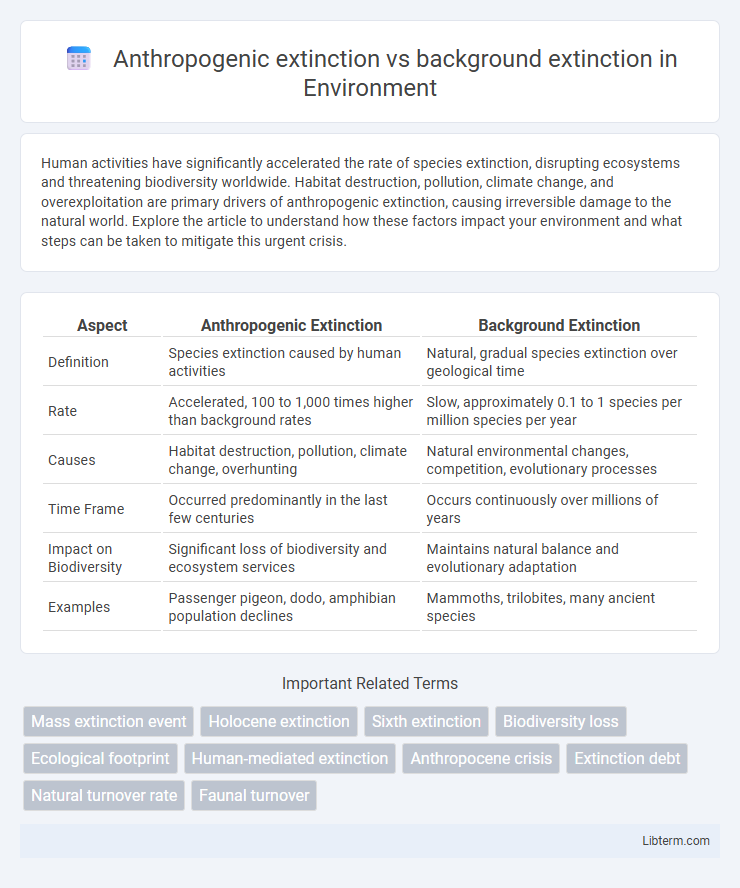Human activities have significantly accelerated the rate of species extinction, disrupting ecosystems and threatening biodiversity worldwide. Habitat destruction, pollution, climate change, and overexploitation are primary drivers of anthropogenic extinction, causing irreversible damage to the natural world. Explore the article to understand how these factors impact your environment and what steps can be taken to mitigate this urgent crisis.
Table of Comparison
| Aspect | Anthropogenic Extinction | Background Extinction |
|---|---|---|
| Definition | Species extinction caused by human activities | Natural, gradual species extinction over geological time |
| Rate | Accelerated, 100 to 1,000 times higher than background rates | Slow, approximately 0.1 to 1 species per million species per year |
| Causes | Habitat destruction, pollution, climate change, overhunting | Natural environmental changes, competition, evolutionary processes |
| Time Frame | Occurred predominantly in the last few centuries | Occurs continuously over millions of years |
| Impact on Biodiversity | Significant loss of biodiversity and ecosystem services | Maintains natural balance and evolutionary adaptation |
| Examples | Passenger pigeon, dodo, amphibian population declines | Mammoths, trilobites, many ancient species |
Defining Anthropogenic Extinction
Anthropogenic extinction refers to species loss driven directly or indirectly by human activities, such as habitat destruction, pollution, climate change, and overexploitation. This type of extinction occurs at rates significantly higher than the natural background extinction rate, which averages about 0.1 to 1 species per million years. Unlike background extinction, anthropogenic extinction results from accelerated environmental pressures linked to industrialization and modern human development.
Understanding Background Extinction
Background extinction refers to the natural, gradual rate at which species disappear due to environmental changes, evolutionary shifts, and ecological interactions over millions of years. It typically occurs at a stable pace, estimated to be about 0.1 to 1 species per million species per year, contrasting sharply with the accelerated rates seen in anthropogenic extinction caused by human activities like habitat destruction and pollution. Recognizing background extinction rates provides essential context for assessing the severity of current biodiversity loss and distinguishes natural evolutionary processes from human-induced impacts.
Major Causes of Anthropogenic Extinction
Anthropogenic extinction results from human activities such as habitat destruction, overexploitation, pollution, and climate change, which accelerate species loss far beyond natural background extinction rates. Background extinction occurs naturally over long geological periods due to environmental shifts and evolutionary processes, typically affecting species at a slower, steady pace. Major causes of anthropogenic extinction include deforestation leading to habitat fragmentation, unsustainable hunting and fishing practices, introduction of invasive species, and greenhouse gas emissions driving global climate change.
Natural Drivers of Background Extinction
Natural drivers of background extinction include volcanic eruptions, climate fluctuations, sea-level changes, and tectonic activity, which cause gradual habitat alterations over millions of years. These factors maintain Earth's biodiversity balance by selectively removing species unable to adapt to environmental shifts. Unlike anthropogenic extinction caused by rapid human impacts, background extinction rates are generally low and part of the planet's long-term ecological dynamics.
Historical Comparison of Extinction Rates
Anthropogenic extinction rates currently exceed background extinction rates by 100 to 1, driven primarily by human activities such as habitat destruction, pollution, and climate change. Historical comparisons reveal that while background extinction occurred at an average rate of 0.1 to 1 species per million species per year over millions of years, current rates have surged dramatically, signaling a sixth mass extinction event. This accelerated loss threatens biodiversity at unprecedented levels compared to natural historical baselines documented through the fossil record.
Human Impact on Biodiversity Loss
Anthropogenic extinction rates are estimated to be 100 to 1,000 times higher than background extinction rates, driven primarily by habitat destruction, pollution, and climate change. Human activities such as deforestation, urbanization, and overexploitation of species critically accelerate biodiversity loss across ecosystems worldwide. Conservation efforts targeting these human impacts are essential to mitigate the unprecedented decline of global species diversity.
Case Studies: Recent vs. Ancient Extinctions
Anthropogenic extinction refers to species loss driven by human activities such as habitat destruction, pollution, and overexploitation, exemplified by the rapid decline of amphibians and megafauna in the past century. Background extinction occurs at a natural, gradual rate over geological time frames, illustrated by ancient events like the Ordovician-Silurian extinction approximately 444 million years ago. Case studies comparing recent extinctions, such as the decline of the passenger pigeon, with ancient extinctions highlight the accelerated and widespread impact of human influence on biodiversity loss compared to baseline natural rates.
Ecological Consequences of Accelerated Extinction
Anthropogenic extinction, driven by human activities such as habitat destruction, pollution, and climate change, occurs at rates significantly higher than natural background extinction, which reflects the baseline loss of species over geological time. Accelerated extinction disrupts ecosystem stability, leading to the loss of biodiversity essential for ecosystem services like pollination, nutrient cycling, and climate regulation. This rapid decline undermines ecological resilience, increases vulnerability to invasive species, and destabilizes food webs, threatening both environmental health and human well-being.
Conservation Strategies to Combat Anthropogenic Loss
Anthropogenic extinction, driven by human activities such as habitat destruction, pollution, and overexploitation, occurs at a rate significantly exceeding the natural background extinction rate. Conservation strategies to combat this accelerated loss focus on habitat restoration, establishing protected areas, enforcing wildlife trade regulations, and promoting biodiversity through community engagement and sustainable practices. Integration of advanced technologies like remote sensing and genetic monitoring enhances the effectiveness of these strategies by enabling precise tracking of species populations and threats.
Future Projections and Global Responsibility
Anthropogenic extinction rates currently exceed background extinction rates by up to 1,000 times, driven primarily by habitat destruction, climate change, and pollution. Future projections indicate that without global coordinated conservation efforts, up to 1 million species could face extinction within the next century, significantly disrupting ecosystems and biodiversity. Addressing this crisis requires equitable international policies and shared responsibility to implement sustainable practices and reduce human impact on natural habitats.
Anthropogenic extinction Infographic

 libterm.com
libterm.com